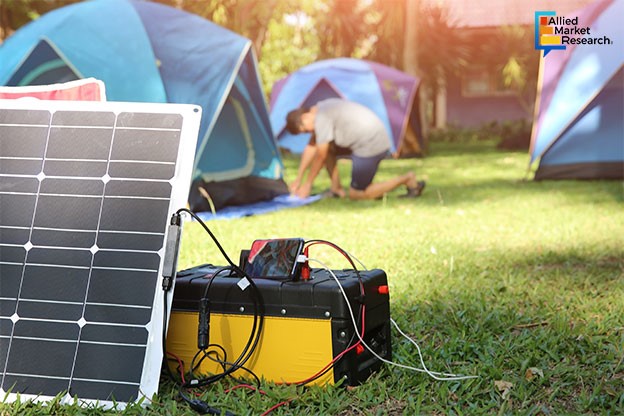Solar Generators: A Shift toward Portable, Cleaner Energy Solutions

29 Apr
2025
Highlights:
- Introduction
- Solar generators delivering steady power
- What’s new in the field
Solar generators have become a reliable energy source for both small-scale and large-scale power needs. These systems use solar panels to capture sunlight and convert it into electrical energy, which is then stored in batteries for later use. Unlike diesel or gasoline-powered generators, solar generators run without noise, harmful emissions, or recurring fuel costs. This makes them useful for companies aiming to cut operational costs and lower carbon footprints.
India’s Renewable Surge and Its Impact on On-Site Power Choices
India recently became the third-largest producer of solar and wind energy in the world. As of early 2024, around 22% of the country’s energy production now comes from renewable sources. This shift is shaping how businesses think about power, especially in areas with unstable electricity supply. Companies operating in telecom, field services, and logistics are actively turning to solar-powered generators to maintain operations without relying on fossil fuels.
Inside the Unit: How Solar Generators Deliver Steady Power
A typical solar generator includes solar panels, a charge controller, a battery storage system, and an inverter. Each component plays a role in converting sunlight into usable energy. Solar panels collect sunlight, the charge controller regulates the flow to the battery, and the inverter changes stored DC power into AC electricity for daily tools and machines. Modern systems are built for portability and come with robust enclosures for use in demanding field conditions.
Remote Operations Now Have a Reliable Power Backup
Businesses working in rural zones or off-grid areas now use solar generators as a steady power supply. These units are being deployed in pop-up clinics, construction sites, and even mobile command units. Event organizers, emergency response teams, and field-based repair crews are also depending on them for uninterrupted service. Their quiet function and emission-free operation help meet both environmental standards and worksite safety rules.
Updates from the Field: What’s New in Solar Generator Tech
Recent advances in solar generator technology include the use of high-efficiency lithium-ion batteries and integrated digital controls. These upgrades allow for quicker charging, longer runtimes, and remote monitoring of energy use. Some newer models even provide app-based control systems, which are helpful for tracking generator performance from a distance. A report by Trak.in highlights India’s energy progress and reflects growing adoption of solar systems, not just in homes, but in active business environments. The solar generator industry accounted for $549.2 million in 2023 and is predicted to gather a revenue of $1.02 billion by 2033, citing a CAGR of 6.5% during 2024-2033.
Breaking Down Costs: Where the Real Savings Come from
While buying a solar generator involves upfront investment, the savings build over time through lower fuel costs and reduced downtime. Since there’s no fuel to refill and fewer moving parts to maintain, businesses can redirect those expenses elsewhere. Some systems get government help or tax breaks if they support clean energy. In outdoor industries like agriculture and cargo handling, solar generators help cut the cost and hassle of transporting fuel to the field.
Usage Constraints That Companies Should Plan for
Despite their benefits, solar generators aren’t flawless. They rely on sunlight, so output can drop on cloudy or rainy days. Businesses need to assess their total energy load and choose a generator with suitable battery storage to bridge power gaps. Dust and shading can also lower panel efficiency, so proper placement and upkeep are essential. In large operations, having staff trained to manage and monitor the system can reduce energy losses and avoid technical setbacks.
Reliable Energy Without Relying on Fuel Supplies
The appeal of solar generators is clear for businesses that want greater control over their energy use. Unlike fuel-based systems, these generators offer energy independence and less risk of supply disruptions. This makes them a strong fit for mobile operations, seasonal work, or short-term projects that need clean, portable electricity.
The Crux
Solar generators are now more than just backups—they’re essential for many industries in tough environments. With better storage, control systems, and battery performance, they meet real business needs. As clean energy use grows and technology gets easier to use, solar generators are becoming a reliable, portable power option for companies.
Reach out to our experts for valuable insights on key growth factors and investment opportunities in the sector!

Koyel Ghosh
Author’s Bio- Koyel Ghosh is a blogger with a strong passion and enjoys writing in miscellaneous domains, as she believes it lets her explore a wide variety of niches. She has an innate interest in creativity and enjoys experimenting with different writing styles. A writer who never stops imagining, she has been serving the corporate industry for the last five years.
Avenue: Entire Library membership of Allied Market Research Reports at your disposal
- Avenue is an innovative subscription-based online report database.
- Avail an online access to the entire library of syndicated reports on more than 2,000 niche industries and company profiles on more than 12,000 firms across 11 domains.
- A cost-effective model tailored for entrepreneurs, investors, and students & researchers at universities.
- Request customizations, suggest new reports, and avail analyst support as per your requirements.
- Get an access to the library of reports at any time from any device and anywhere.
Related Post
-
How are Submarine Cables Transforming Global Connectivity with Enhanced User Experience?
-
Endoscopy Procedures: Transformations in Techniques and Applications
-
AI-Powered Video Analytics: How the Product Actually Works for enterprises
-
Painting Robots: Transforming Precision Coating and Creative Applications
-
Innovations in Pharmacovigilance Systems Advancing Patient Safety
-
Understanding Edge Security: Keeping Data Safe Near the Source
-
Exploring the Use and Advancements of 3D Laser Scanners in Professional Applications
-
Reinforcing Industrial Controls with Smarter Tools and Training








